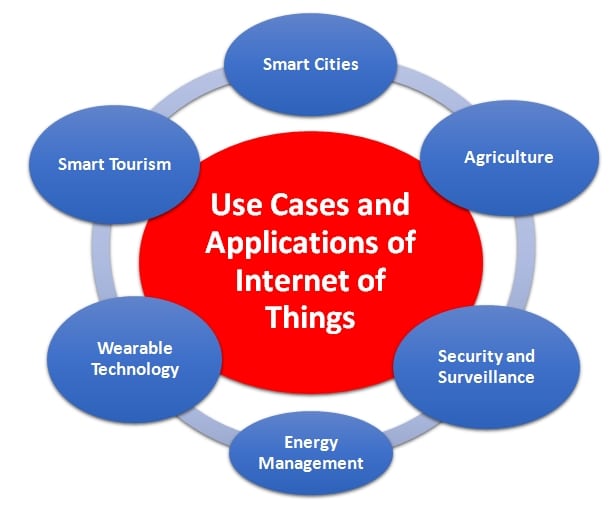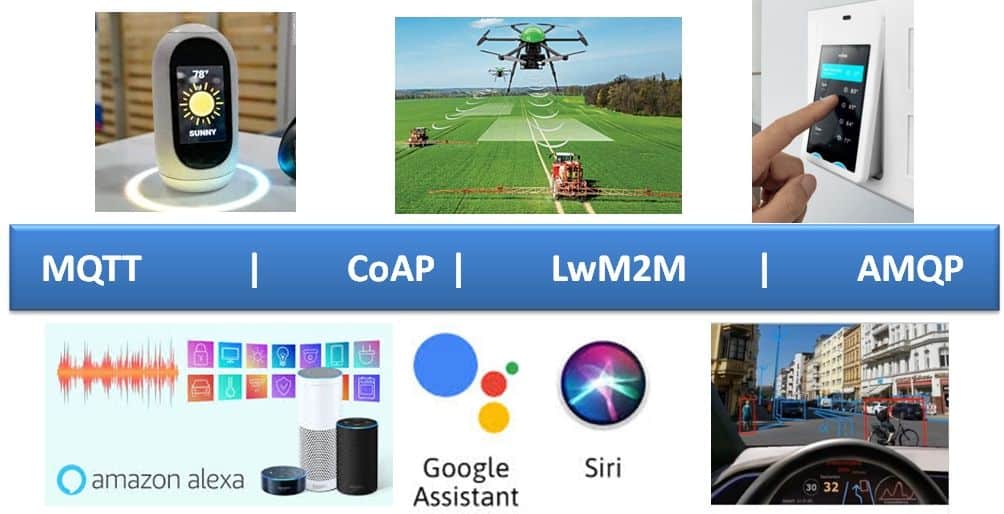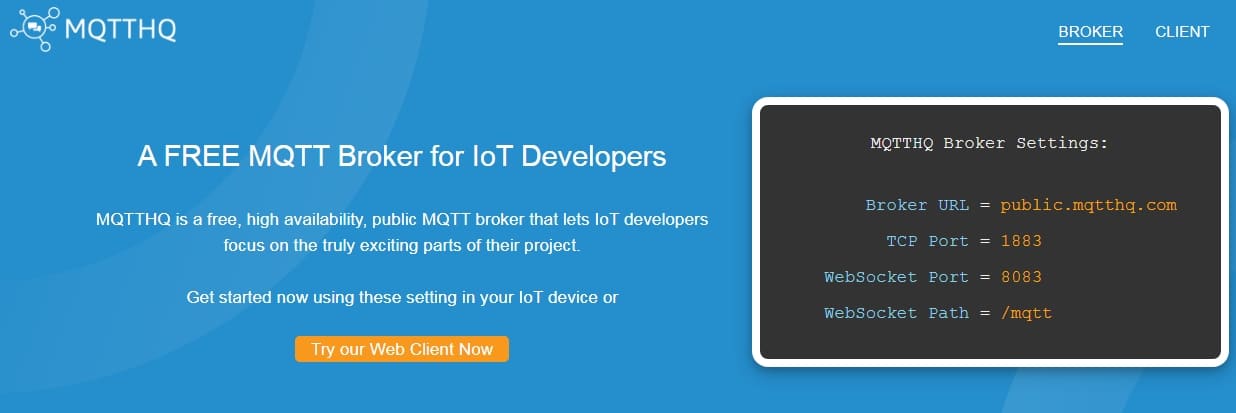Working with IoT protocols like MQTT, AMQP, and CoAP on cloud platforms is essential for developing scalable and efficient IoT applications. The choice of the programming platform will depend on factors like project requirements, existing skills, and target devices. Leveraging the appropriate libraries and cloud services can enable seamless integration of IoT devices with cloud-based applications.
The Internet of Things (IoT) has ushered in a technological revolution, transforming the way we interact with the world around us. Its applications are vast and diverse, spanning numerous industries and sectors.
One of the most prevalent and impactful use cases of IoT can be found in the realm of smart home automation. IoT devices like smart thermostats, lighting systems, security cameras, and appliances enable homeowners to control and monitor their homes remotely, enhancing convenience, energy efficiency, and security. Some major IoT use cases have been catalogued in Table 1.
Table 1: Prominent and notable IoT use cases
Smart home automation
|
Industrial IoT (IIoT)
|
Healthcare
|
Transportation and logistics
|
Agriculture
|
Smart cities
|
Retail
|
Energy management
|
Environmental monitoring
|
Smart buildings
|
Supply chain
|
Security and surveillance
|
Smart farming
|
Health and fitness
|
Water management
|
Manufacturing
|
Smart tourism
|
Education
|
Wearable technology
|
Sports and entertainment
|
Industrial IoT (IIoT) is pivotal in the industrial sector, optimising operations through predictive maintenance, asset tracking, quality control, and supply chain management. This leads to reduced downtime, improved productivity, and data-driven decision-making, enhancing competitiveness.

In healthcare, IoT aids remote patient monitoring and wearable health devices, resulting in better health outcomes and reduced costs. Transportation and logistics benefit from IoT through vehicle tracking, fleet management, and traffic optimisation, boosting safety and efficiency. There are a range of applications in other domains too.
- Agriculture: Embraces IoT for precision farming, improving crop yields and sustainability
- Smart cities: Leverage IoT for traffic management, waste optimisation, and environmental monitoring, making urban areas more efficient and sustainable
- Retail: Uses IoT for inventory management and personalised shopping experiences
- Energy management: This is enhanced by IoT, with smart grids and energy consumption monitoring promoting sustainability
- Environmental monitoring: IoT sensors aid in tracking wildlife, water quality, and pollution levels, contributing to conservation efforts
- Smart buildings: Utilise IoT for energy optimisation and security
- Supply chain management: Relies on real-time tracking and inventory optimisation
- Security and surveillance: IoT enhances security and surveillance with advanced camera and sensor technologies
IoT also plays a crucial role in water management, tourism, education, wearables, and sports and entertainment, offering a wide range of benefits across these domains.
Key protocols in IoT implementations
In the world of IoT implementations, protocols play a pivotal role in enabling devices to communicate, exchange data, and function seamlessly within the IoT ecosystem. One of the foundational protocols is MQTT (Message Queuing Telemetry Transport), known for its lightweight and efficient nature. MQTT is ideal for scenarios where low bandwidth and minimal power consumption are crucial. This makes it a popular choice for IoT devices, especially in remote and resource-constrained environments.
HTTP (Hypertext Transfer Protocol), a protocol well-known in web communication, also plays a significant role in IoT. With the emergence of RESTful APIs, IoT devices can communicate with web servers over HTTP, enabling seamless integration with web applications and services. This simplifies data exchange and provides a familiar interface for developers.
On the other hand, CoAP (Constrained Application Protocol) is designed explicitly for IoT devices with limited resources. It operates like HTTP but with optimisations for low-power and constrained environments. CoAP is well-suited for IoT implementations where efficiency and scalability are paramount.
For IoT applications that require real-time communication and low latency, WebSocket is a critical protocol. It enables full-duplex communication between devices and servers, allowing for instantaneous data exchange. This protocol is particularly valuable in scenarios like remote control and monitoring.
AMQP (Advanced Message Queuing Protocol) is another protocol that finds its place in IoT implementations, especially in scenarios requiring reliable message queuing and routing. It provides a robust framework for message-oriented middleware, ensuring messages reach their destinations efficiently and safely.
In industrial and enterprise IoT applications, Modbus and BACnet are prevalent protocols. Modbus is used extensively in industrial control systems and automation, facilitating communication between devices like sensors and programmable logic controllers. BACnet, on the other hand, is focused on building automation and HVAC systems, ensuring interoperability and efficient data exchange in smart buildings.
Lastly, Bluetooth and Zigbee are wireless communication protocols that dominate IoT implementations in smart homes and personal area networks. Bluetooth is well-known for its versatility and widespread adoption in consumer devices, while Zigbee excels in low-power, mesh network applications, often found in home automation setups.
In IoT, the choice of protocol depends on various factors such as the nature of the application, resource constraints, scalability requirements, and interoperability needs. The seamless integration of these key protocols is essential for creating a robust and interconnected IoT ecosystem that enables devices to communicate and deliver the benefits of IoT to users and businesses alike.

Working with IoT protocols on cloud
Working with IoT protocols such as MQTT, AMQP, and CoAP on cloud platforms is crucial for building scalable and efficient IoT applications. These protocols facilitate communication between devices and cloud services, allowing for data exchange, control, and management of IoT devices. Developers can work with these protocols using various programming platforms like Python, Node.js, Java, and more, depending on their preferences and project requirements.
Python is a versatile and widely-used language for IoT development. To work with IoT protocols in Python, developers can use libraries and frameworks such as Paho MQTT for MQTT, the RabbitMQ library for AMQP, and CoAPthon for CoAP. These libraries enable developers to establish connections, publish and subscribe to topics, and handle messages efficiently. When combined with cloud services like AWS IoT, Azure IoT Hub, or Google Cloud IoT, Python allows seamless integration of IoT devices with cloud platforms.
Node.js, known for its asynchronous and event-driven architecture, is also a popular choice for IoT development. Developers can use libraries like MQTT.js for MQTT, AMQP10 for AMQP, and CoAP for CoAP. Node.js’s non-blocking I/O model makes it well-suited for handling numerous IoT device connections simultaneously, making it a great choice for IoT gateway applications that connect devices to the cloud.
Java is a robust and platform-independent language for building IoT applications. It offers libraries like Eclipse Paho for MQTT, Apache Qpid for AMQP, and Californium for CoAP. Java’s strong community support and extensive libraries make it a reliable choice for developing IoT applications that need to run on different platforms and devices.
Other programming platforms such as C/C++ can be used for IoT protocol implementations when working with resource-constrained devices. Libraries like Eclipse Mosquitto for MQTT, RabbitMQ for AMQP, and microcoap for CoAP enable efficient communication with cloud platforms.
Working with MQTT, AMQP and CoAP
Working with cloud-based MQTT, AMQP, and CoAP protocols using Python is a common approach for developing IoT applications that require efficient communication between devices and cloud services. Below, we’ll outline how to work with each of these protocols in a cloud environment using Python.
MQTT (Message Queuing Telemetry Transport): MQTT is a lightweight and widely-used protocol for IoT communication. To work with MQTT in a cloud-based environment using Python, you can follow these steps.
1. Install the Paho MQTT library, a popular MQTT client library for Python, using pip:
pip install paho-mqtt |
Figure 3 presents a cloud based MQTT broker that serves as a critical component in an IoT project. However, the process of setting up, troubleshooting, monitoring, and sustaining such a broker can be intricate and time-intensive. MQTTHQ is an intricately designed, load-balanced, multi-node MQTT broker cluster. It has been meticulously crafted to offer a steadfast and exceptionally reliable broker environment for the development of IoT products and applications. MQTTHQ extends its support to both TCP and WebSocket connections. The project integration can instantaneously transmit and receive messages via the public.mqtthq.com broker, all without the need to delve into coding intricacies.

2. Import the Paho MQTT library in your Python script:
import paho.mqtt.client as mqtt |
The Paho MQTT library stands as a cornerstone in the world of IoT and messaging protocols. This open source library, developed by the Eclipse Foundation, empowers developers to effortlessly integrate MQTT communication into their applications.
Offering support for multiple programming languages, including Python, Java, and JavaScript, Paho simplifies the process of connecting devices, exchanging messages, and managing MQTT connections. Its lightweight and efficient design makes it a go-to choice for IoT projects, ensuring seamless communication between devices and MQTT brokers. With Paho MQTT, developers can harness the power of MQTT for building robust and scalable IoT solutions with ease.
3. Create an MQTT client instance and set up the connection to the MQTT broker on the cloud platform:
client = mqtt.Client(client_id=”your_client_id”)client.connect(“mqtt_broker_address”, port=1883) |
Use the client to publish and subscribe to MQTT topics. You can send data from your IoT devices to the cloud by publishing to a specific topic and subscribe to topics to receive commands or updates from the cloud.
AMQP (Advanced Message Queuing Protocol): AMQP is a robust and feature-rich messaging protocol. To work with AMQP in a cloud-based environment using Python:
1. Install an AMQP library like `pika` for Python using pip:
pip install pika |
2. Import the `pika` library in your Python script:
import pika |
3. Create a connection to the AMQP broker on the cloud platform:
connection = pika.BlockingConnection(pika.ConnectionParameters(‘amqp_broker_address’))channel = connection.channel() |
3. Declare queues and exchanges for message routing, ensuring they match the setup on your cloud-based AMQP service.
4. Use the ‘channel’ object to publish and consume messages from the queues. You can publish data from your IoT devices and consume messages sent from the cloud.
CoAP (Constrained Application Protocol): CoAP is a lightweight and efficient protocol designed for resource-constrained IoT devices. To work with CoAP in a cloud-based environment using Python:
1. Install a CoAP library like ‘aiocoap’ for Python using pip:
pip install aiocoap |
2. Import the `aiocoap` library in your Python script:
import aiocoap |
3. Create a CoAP client instance and set up the connection to the CoAP server (usually provided by your cloud-based service):
context = await aiocoap.Context.create_client_context()uri = “coap://coap_server_address/resource” |
4. Use the client to send CoAP requests (GET, PUT, POST, etc) to retrieve or update data on the cloud server. CoAP follows a RESTful architecture, so you interact with resources using standard HTTP-like methods.
Working with MQTT, AMQP, and CoAP in a cloud-based environment using Python allows you to create powerful and scalable IoT applications. Ensure that you have the necessary credentials and access rights to connect to the cloud-based services, and that you properly configure your Python script to match the cloud platform’s settings and requirements.
As technology advances and connectivity expands, IoT’s influence will only grow, opening new horizons and opportunities for businesses and individuals alike.
When working with cloud platforms for IoT, consider using IoT-specific cloud services like AWS IoT Core, Azure IoT Hub, or Google Cloud IoT Core. These services simplify device registration, message routing, and device management, making it easier to integrate IoT devices with cloud applications.












































































